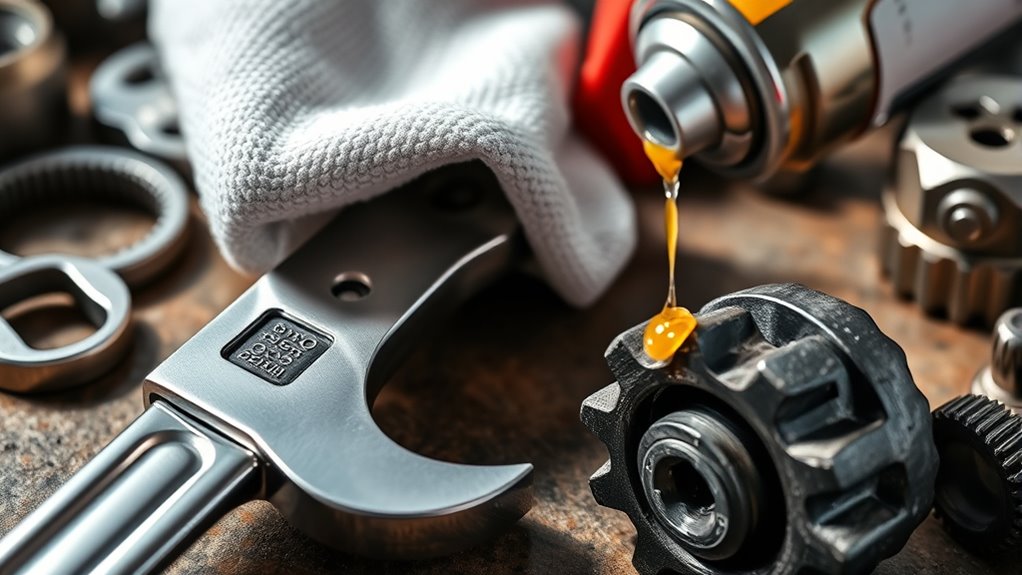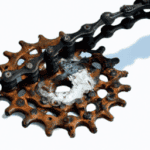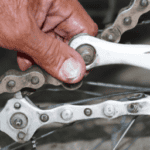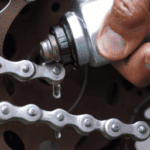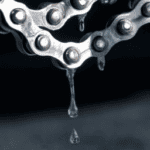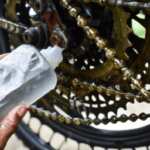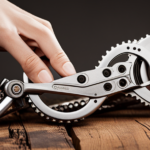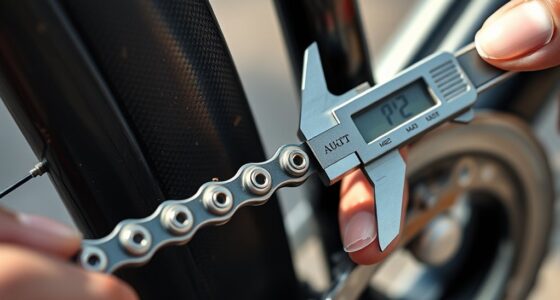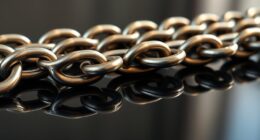Cleaning removes dirt, rust, and debris from your tools, guaranteeing they stay in good condition, while lubricating involves applying oils or grease to moving parts to keep them operating smoothly and prevent wear. Both steps are essential; cleaning prepares the surface, and lubrication ensures smooth movement. Different tools need specific care—some require more attention to rust removal, others need precise lubrication. Stick with this guide to master the proper cleaning and lubricating techniques for each tool type.
Key Takeaways
- Cleaning removes dirt, debris, rust, and residues to maintain tool efficiency and prevent damage.
- Lubricating reduces friction, prevents rust, and ensures smooth operation of moving parts.
- Tools with blades or cutting edges require cleaning to remove pitch and debris, then lubrication for rust prevention.
- Power tools need cleaning of vents and internal parts, followed by lubrication of joints and moving components.
- Proper maintenance involves cleaning first, then applying lubricant to prolong tool lifespan and ensure optimal performance.
Hand Tools: Cleaning and Lubrication Needs

To keep your hand tools in ideal condition, you should clean and lubricate them regularly. Proper cleaning removes dust, dirt, and debris that can cause buildup and hinder performance. After use, wipe your tools with a dry cloth to prevent moisture. For caked-on grime or rust, use a stiff-bristle brush or steel wool, then wipe with a clean, dry cloth. If your hand tools are oily or greasy, clean them with mild soap and warm water, then dry thoroughly to prevent rust. Applying a light coat of machine oil or WD-40 to moving parts and joints helps ensure smooth operation and guards against rust formation. Regular maintenance, including cleaning and lubrication, preserves your tools’ performance and extends their lifespan. Being aware of symptoms of rust or corrosion can help you identify when your tools need more intensive care. Additionally, understanding tool maintenance best practices can further enhance their longevity and reliability.
Power Tools: Proper Maintenance Procedures
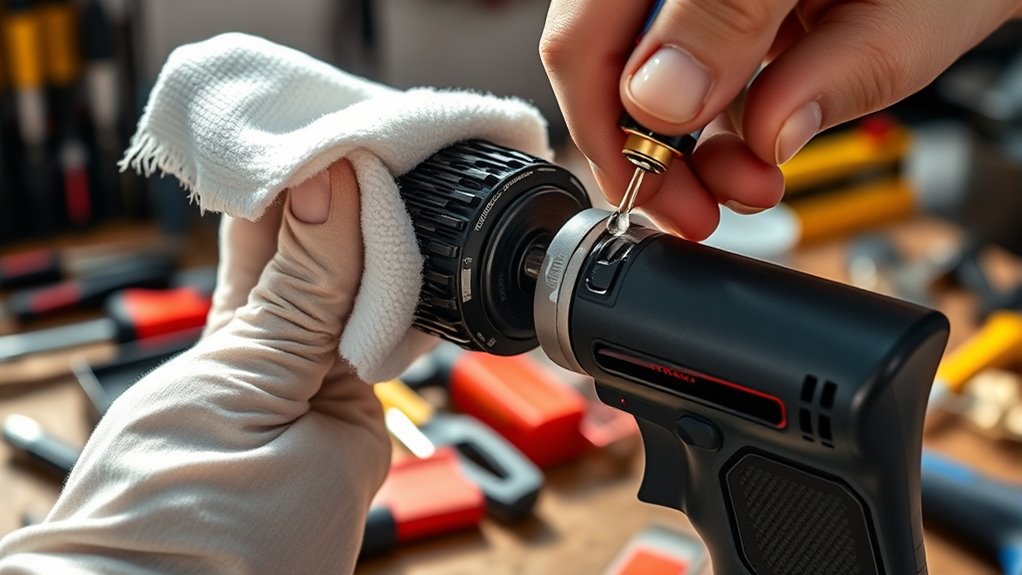
To keep your power tools running smoothly, you’ll need to follow proper cleaning and inspection steps regularly. Start by unplugging the tool and using compressed air to remove dust, then wipe down surfaces with a damp cloth. Don’t forget to check cords and switches for damage and apply lubrication to moving parts for peak performance. Regular maintenance, such as Mazda Tuning upgrades, can also extend the lifespan of your tools and improve their efficiency. Additionally, using the correct type of maintenance products can further protect your equipment and ensure optimal operation. Proper Audi Tuning techniques can also help maintain your tools’ condition and performance over time. Remember that choosing the right lubricants based on the tool’s components is essential for preventing wear and tear. Incorporating routine cleaning practices can prevent buildup and ensure your tools stay in top shape for longer.
Cleaning Techniques and Tips
Proper cleaning of power tools is essential for maintaining their performance and extending their lifespan. To keep your tools in top shape, follow these tips:
- Use compressed air to blow dust and debris from vents, switches, and motor housings, but always unplug or remove the battery first. This technique aligns with industry transformations where automation and maintenance are key to efficiency. Additionally, employing the right cleaning techniques ensures thorough removal of contaminants without damaging internal components.
- Wipe exterior surfaces with a damp cloth, and apply rubbing alcohol to stubborn grime, avoiding excess moisture that could damage internal parts.
- Clean blades, bits, or attachments with manufacturer-recommended solvents, then dry thoroughly to prevent rust.
- Pay attention to color accuracy in the visual components of your tools, especially if they include displays or visual indicators, to ensure clear and accurate readings or signals.
- Regularly inspect electrical cords and plugs for damage, replacing worn components as needed. Proper cleaning is crucial for effective tool care and maintenance, helping prevent rust and ensuring peak performance. Additionally, consider corrosion prevention techniques to protect metal parts from moisture and environmental damage. Proper maintenance practices are vital for extended tool lifespan, ensuring your equipment remains reliable over time.
Lubrication and Inspection Steps
Regular inspection of your power tools is essential before applying lubrication, as it helps identify signs of wear, damage, or rust that could affect performance. During routine inspection, check for dust and debris buildup, especially around vents, switches, and internal components. Use compressed air to blow out dirt, preventing it from contaminating moving parts. Once clean, apply lubrication such as WD-40 or 3-in-1 oil to all moving parts, bearings, and joints every 3-6 months or after cleaning. Work the lubricant into joints by opening and closing the tool or running it briefly. Afterward, wipe off any excess oil to avoid dust accumulation. Regular inspection combined with proper lubrication helps reduce friction, prevent excessive wear, and maintain optimal tool performance. Incorporating preventive maintenance techniques can further extend the lifespan of your equipment and ensure consistent operation. Additionally, understanding energy efficiency techniques can inspire ways to optimize your equipment’s efficiency and longevity.
Wrenches and Ratchets: Keeping Moving Parts Smooth
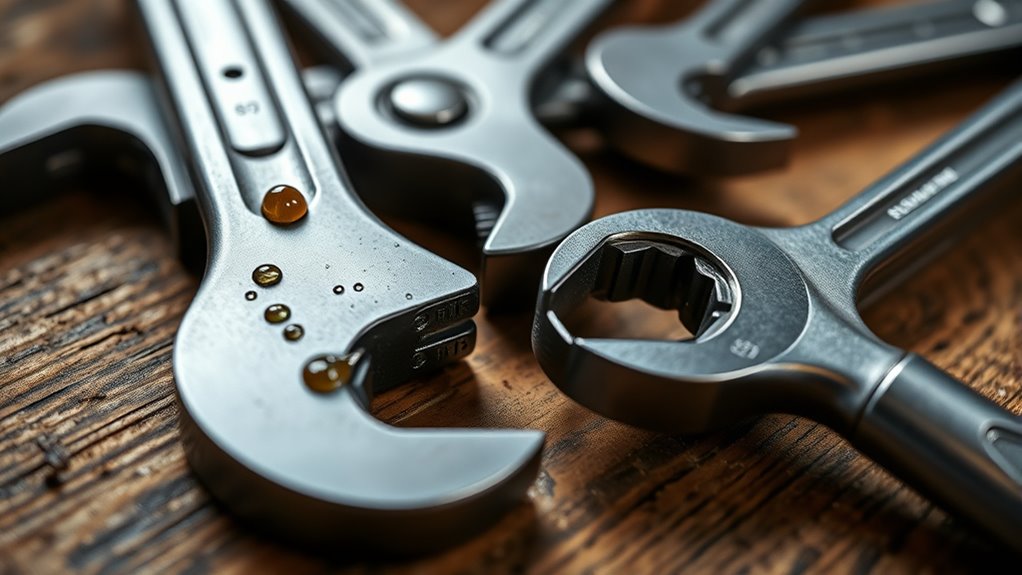
To keep your wrenches and ratchets working smoothly, you need to regularly remove debris and rust from their moving parts. Applying a proper, light coating of lubricant helps prevent corrosion and guarantees effortless operation. Remember to disassemble and clean your tools periodically, so they stay in top shape and perform reliably.
Removing Debris and Rust
Cleaning rust from wrenches and ratchets is vital to keep their moving parts functioning smoothly. To prevent rust and guarantee effective tool maintenance, start with rust removal by applying penetrating oil or rust remover, letting it sit for a few minutes. Then, use a wire brush or steel wool to scrub away corrosion, focusing on joints and moving surfaces. Next, rinse with water or wipe with a damp cloth to remove residual rust remover, then dry thoroughly. Finally, work the ratchet or wrench back and forth to distribute lubricant evenly and promote smooth movement. Regular cleaning and working to remove debris and rust are essential for corrosion protection and maintaining ideal performance of your tools. Incorporating proper storage practices can further extend the lifespan of your tools by minimizing exposure to moisture and debris.
Applying Proper Lubrication
After removing rust and debris, applying proper lubrication is key to keeping your wrenches and ratchets operating smoothly. You should lubricate the moving parts, such as pivot points, gears, and joints, with a few drops of light machine oil or a manufacturer-recommended lubricant. This helps prevent wear and ensures smooth operation. Work the lubricant into the wrench or ratchet by opening and closing it several times, which distributes the oil evenly. Remember, avoid over-lubricating, as excess oil can attract dirt and debris, causing buildup and potential damage. Regular lubrication after cleaning or when you notice stiffness or squeaking will keep your tools functioning efficiently and extend their lifespan. Proper care makes all the difference in maintaining peak performance. Using the right lubrication techniques ensures your tools stay in top condition for years to come. Additionally, choosing the correct type of lubricant, such as light machine oil, is essential to avoid damage and ensure compatibility with your tools. Incorporating preventative maintenance into your routine can further enhance tool longevity and performance.
Garden Tools: Cleaning and Rust Prevention
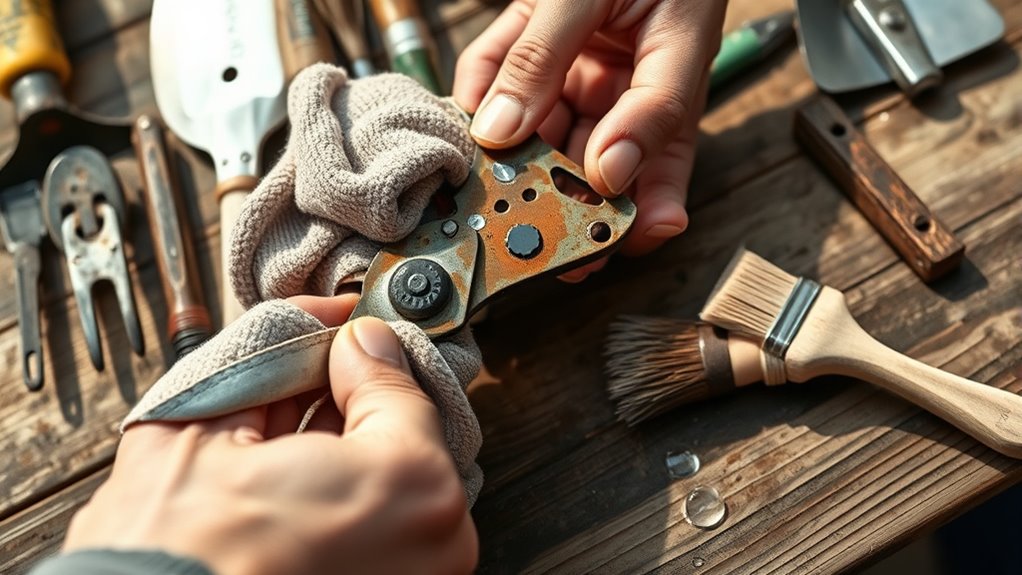
Keeping your garden tools in top shape requires more than just occasional use; regular cleaning and rust prevention are essential. After each use, focus on cleaning garden tools by wiping off dirt and scrubbing stubborn grime with a stiff brush. To prevent rust, remove rust from metal parts using steel wool or wire brushes, then rinse and dry thoroughly. Next, apply a light coat of horticultural or vegetable oil to blades, pruners, and trowels to create a rust-resistant barrier. Proper storage solutions, like hanging tools in a dry, ventilated space, help minimize moisture exposure. Finally, regularly inspect your tools for rust or damage, reapplying oil as needed. This routine supports effective tool maintenance and extends the lifespan of your garden tools.
Saws and Blades: Sharpening, Cleaning, and Lubrication
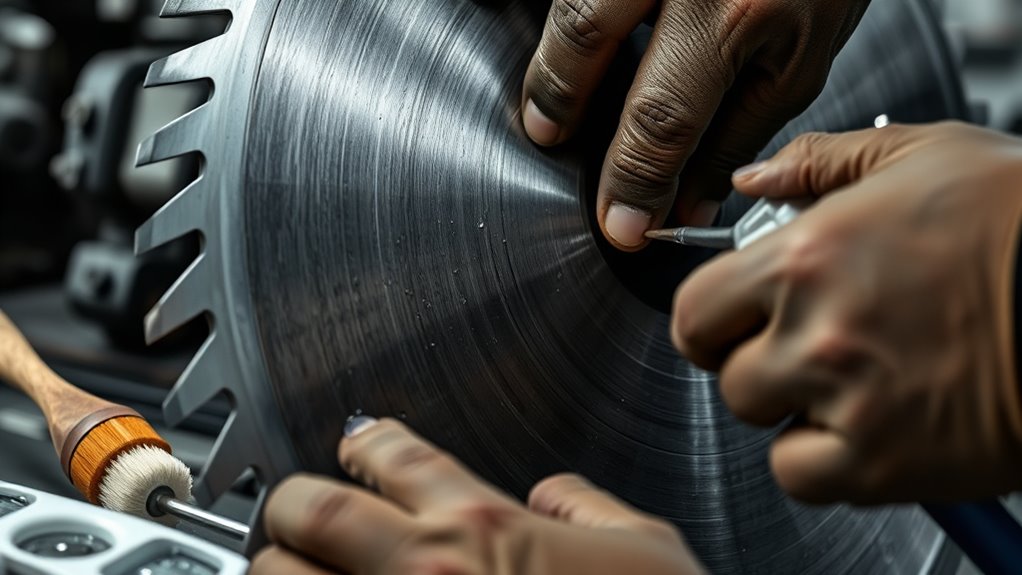
Keeping your saw blades sharp, clean, and well-lubricated is essential for safe, efficient cuts. Regularly inspect for dullness or damage, and clean off resin and debris with a brush and solvent. Don’t forget to lubricate moving parts to guarantee smooth operation and prevent rust.
Sharpening Techniques and Tips
Sharpening your saws and blades is essential for maintaining their cutting efficiency and safety. To do this effectively, follow these key tips:
- Use a fine-tooth file or specialized sharpening stone to restore the teeth at the manufacturer’s recommended angle, ensuring precision.
- Clean blades thoroughly with a stiff brush and a mixture of water and mild detergent or vinegar to remove resin, pitch, and debris before sharpening.
- Lubricate blades and other parts with light machine oil after cleaning to prevent rust and promote smooth operation.
Regular inspection for chips or dullness helps catch issues early. Proper sharpening and maintenance keep your tools performing efficiently and extend their lifespan.
Cleaning for Rust and Debris
To prevent rust and guarantee your blades cut efficiently, it’s important to regularly remove sawdust, pitch, and debris with a wire brush or steel wool. Clean tools after each use to prevent rust and maintain peak performance. When cleaning your tools, use a damp cloth with mild soap, then dry thoroughly to keep moisture at bay. For tools that come with heavy rust, specialized rust removers or vinegar work well—just scrub gently to avoid damaging the teeth. Always clean and dry your blades before storage. Tools require regular maintenance to stay in top shape, and neglecting cleaning can lead to corrosion. By keeping your blades clean and dry, you extend their lifespan and ensure they cut smoothly every time.
Lubrication for Smooth Operation
Applying a light coating of machine oil to your saw blades and moving parts is essential for smooth operation. Proper lubrication reduces friction, prevents rust, and keeps your tools performing at their best. To maintain peak performance, follow these steps:
- Apply a few drops of oil on the blade’s arbor hole and pivot points before and after use.
- Wipe off any excess lubricant to avoid dust and debris buildup that could impair your tools.
- Regularly check and reapply lubrication during maintenance to ensure consistent smooth operation.
This routine not only enhances cutting efficiency but also minimizes wear and extends the lifespan of your blades and gears. Proper cleaning combined with effective lubrication is key to keeping your tools in top condition.
Clamps and Vises: Maintenance for Optimal Grip
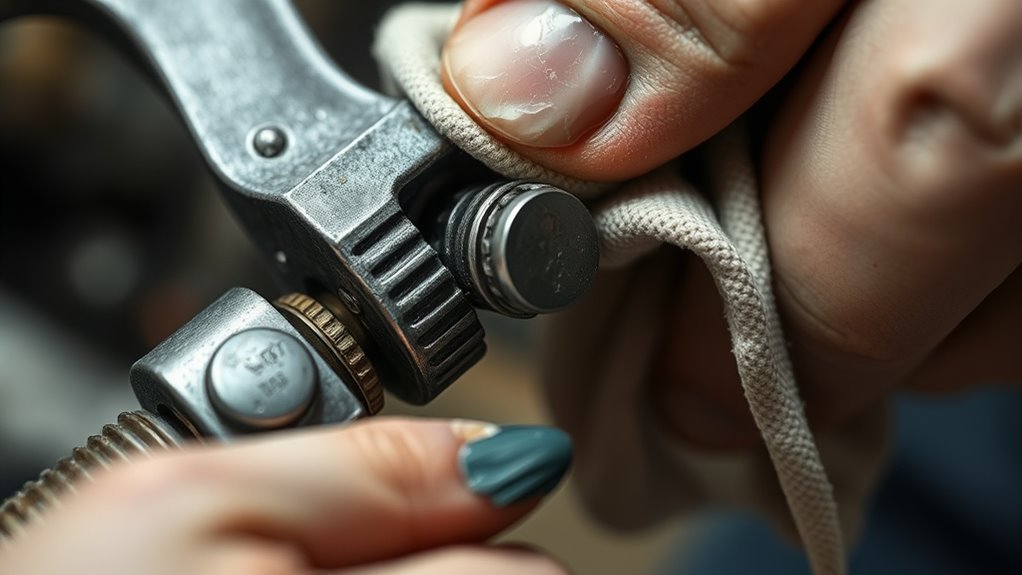
Maintaining clamps and vises is essential for ensuring they deliver a secure grip and accurate results. Regular cleaning with a dry cloth removes debris that can weaken grip strength. Applying a light coat of machine oil to screw threads and sliding parts keeps operation smooth and prevents rust. Inspect jaws for wear, cracks, or damage, and replace or repair them promptly to sustain clamping force. Lubricating moving parts with WD-40 or 3-in-1 oil enhances functionality. Store your tools in a dry environment and periodically check for rust or corrosion. Proper maintenance prolongs tool life and guarantees consistent performance.
| Maintenance Step | Purpose |
|---|---|
| Cleaning | Prevent debris buildup, maintain grip |
| Lubricating | Ensure smooth operation, reduce rust |
| Inspection | Detect damage or wear early |
| Replacement/Repair | Maintain secure clamping force |
| Storage | Protect from rust and corrosion |
Drill Bits and Attachments: Cleaning and Ensuring Longevity

Regular cleaning of your drill bits and attachments is essential for maintaining their cutting efficiency and preventing corrosion. Proper care involves a few simple steps:
- After each use, wipe your drill bits with a cloth to remove debris and metal shavings, ensuring no residue hampers performance.
- For rust removal, use a wire brush or steel wool on high-carbon or high-speed steel bits, then soak in a rust remover or vinegar for deep cleaning. Rinse and dry thoroughly to avoid corrosion.
- Before storage, lubricate metal parts with light machine oil to prevent rust and facilitate tool maintenance. Store in a dry, organized container, preferably with silica gel packs to minimize moisture.
Following these steps ensures your drill bits stay sharp, rust-free, and ready for future projects.
Measuring Instruments: Preserving Accuracy and Cleanliness
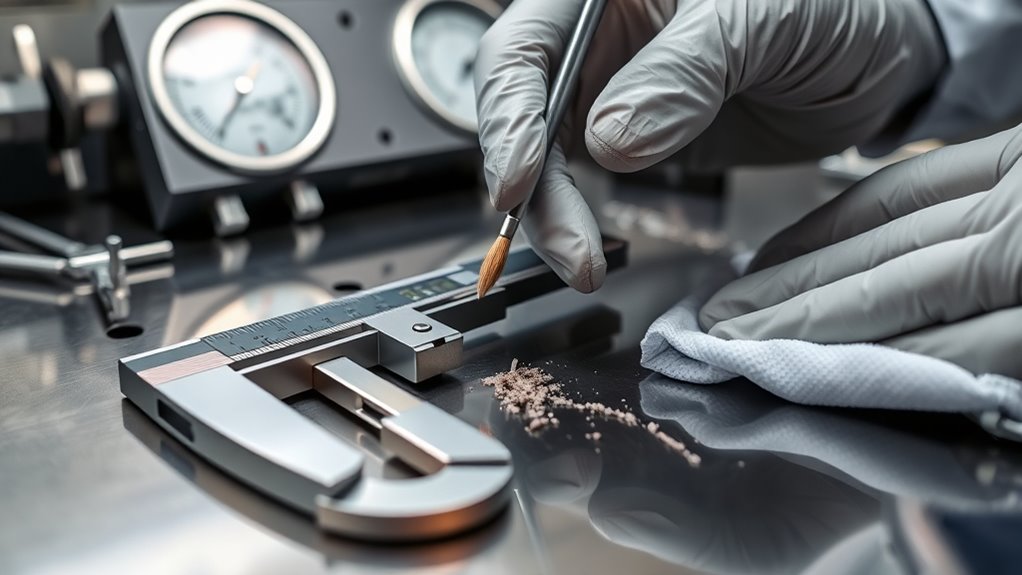
To make sure your measuring instruments provide accurate readings, it’s vital to keep them clean and well-maintained. Regular cleaning with a soft, lint-free cloth prevents dust and dirt from accumulating, which can compromise accuracy. For stubborn residues like grease or oil, use appropriate cleaning solutions such as isopropyl alcohol or specialized instrument cleaners that won’t damage delicate surfaces. Proper storage is essential—keep measuring tools in protective cases or designated drawers to shield them from humidity, impacts, and environmental damage. Remember to calibrate your instruments periodically following manufacturer instructions to guarantee precision. Protect your measuring instruments from extreme temperatures, moisture, and corrosive substances. Consistent maintenance and careful handling preserve their accuracy and extend their lifespan.
Heavy Equipment: Routine Cleaning and Lubrication Strategies
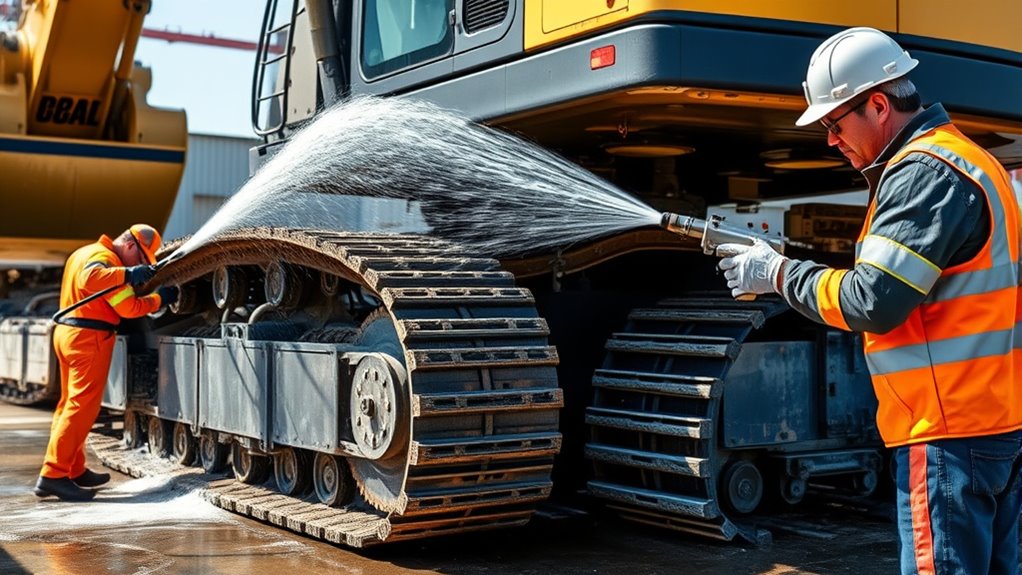
Effective maintenance of heavy equipment involves consistent cleaning and lubrication to keep it running smoothly. To guarantee peak performance, focus on these key strategies:
- Use compressed air to clean dust and debris from vents, filters, and hard-to-reach areas, preventing overheating and wear.
- Regularly lubricate moving parts with gear oil, hydraulic oil, or grease every 50-100 hours, reducing friction and corrosion.
- Remove rust with a wire brush or rust remover before applying lubrication, protecting metal surfaces and maintaining smooth operation.
Wipe down external surfaces with a damp cloth and light oil, especially after exposure to moisture. Following manufacturer guidelines guarantees effective maintenance and prolongs your heavy equipment’s lifespan.
Specialty Tools: Custom Care for Unique Maintenance Requirements
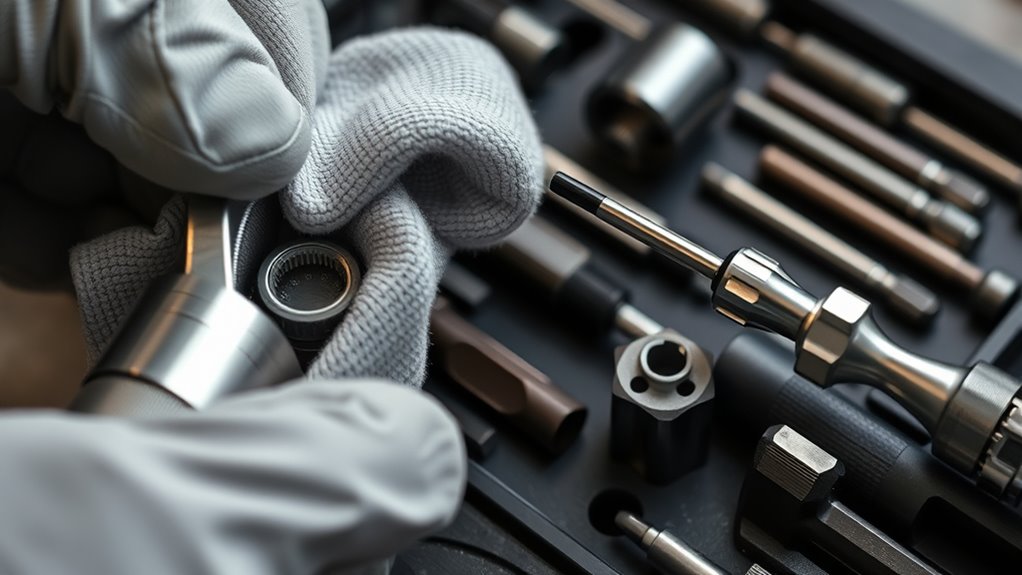
Specialty tools demand tailored maintenance to guarantee their precision and longevity. You must use specific cleaning agents like rust inhibitors or ultrasonic cleaners to avoid damaging delicate components. Gentle lubrication with specialized oils preserves accuracy without attracting debris or causing corrosion. Power rotary tools with embedded electronics require careful cleaning, avoiding water or harsh chemicals that could cause short circuits. Proper reassembly involves precise torque settings and alignment, often needing calibration after cleaning. Protect your tools during storage with rust inhibitors or protective cases to maintain their surfaces and performance.
| Maintenance Step | Consideration |
|---|---|
| Cleaning agents | Use rust removers or ultrasonic cleaners |
| Lubrication | Apply specialized oils for delicate parts |
| Storage | Use rust inhibitors or protective coatings |
Frequently Asked Questions
What Are the 9 Steps in Cleaning Tools?
When cleaning your tools, start by removing loose dirt with a dry cloth or brush. Next, scrub stubborn grime with suitable solutions, then apply rust remover if needed. Rinse thoroughly, dry completely to prevent rust, and inspect for damage. Lubricate moving parts to guarantee smooth operation, reassemble if necessary, and store your tools properly. Following these steps keeps your tools in top condition and ready for use.
Is WD-40 Good for Cleaning Tools?
WD-40 is good for cleaning tools because it helps loosen grime, grease, and light rust. You apply it, let it sit briefly, then wipe or scrub with a cloth or brush. However, it’s not ideal for deep cleaning caked-on dirt or heavy rust, as it’s mainly a penetrating oil and water displacer. For thorough cleaning, consider using dedicated cleaning agents alongside WD-40 for the best results.
What Is the Best Way to Clean Mechanic Tools?
Think of your tools as soldiers needing care after battle. To clean them, start by removing loose dirt with a stiff brush or dry cloth. For greasy spots, wash with mild soap and warm water, then dry thoroughly. Apply a rust-preventative spray or light oil to protect against corrosion. For stubborn grime, use baking soda paste or degreasers. Regular inspection and prompt cleaning keep your tools in top shape.
What Do You Use to Lubricate Tools?
When it comes to lubricating your tools, you should use the right type of lubricant for each. Light machine oil like 3-in-1 or sewing machine oil works well for moving parts, while silicone spray or specialized lubricants are best for power tools to reduce friction. For heavy-duty machinery, opt for high-viscosity grease. Remember, don’t over-lubricate—wipe off excess to keep your tools running smoothly and prevent dirt buildup.
Conclusion
Remember, taking care of your tools isn’t just about cleaning or lubricating—it’s about ensuring they serve you well for years to come. Regular maintenance keeps everything running smoothly and prevents costly repairs. As the saying goes, “A stitch in time saves nine.” By tending to your tools promptly, you’ll keep your projects on track and your tools in top shape, making your work easier and more efficient every step of the way.
